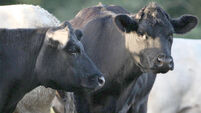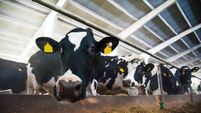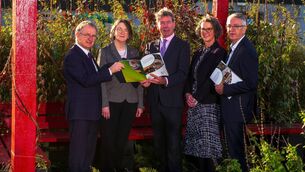The 50 most frequently asked dairy questions
For moderate sized herds, the recommendation is to have 6-7 rows of cows. This will allow the herd to be milked in about one hour. For example, a 10-unit parlour for 70 cows, a 14-16 unit parlour for 100 cows.
A basic milking machine will contain a vacuum pump, milk line, vacuum line and wash line and a milk receiver jar with a milk pump. There are many extras and automations that can be added. These include cluster removers, milk metres, auto gates, dump line, auto feeders, auto drafting, cluster flush and many more.
The basic machine will cost about €2,000 per milking unit; including all of the extras will push the cost per unit up to €8,000. In addition the cost for the building, dairy, collecting yard with tank is about €4,000 per unit.
Second hand machines can be good value, but take into account the cost of installing them.
A new tank will cost €1.75 to €2.50 per litre of capacity.
Ideally, the parlour should be sited in the middle of the grazing area. Cows will be walking to and from the grazing area about 1,000 times in the year.
The size of the tank will depend on the peak number of cows to be milked, their yield and the number of collections per week by the co-op. Some co-ops are moving to three day collections, so the bulk tank should have enough capacity for 3.5 milkings.
For example, 100 cows x 28 litres/day x 3.5 milkings = 9,800 litres bulk tank required.
The most profitable cow will calve in spring, go back in calf (365 day calving interval) easily, milk for 280 days plus, and produce high milk solids from grass.
The Economic Breeding Index (EBI) is a measure of the genetic potential of an animal.
The index is based on €0, and is comprised of seven sub-indices (milk, fertility, health, maintenance, beef, calving and management). When purchasing dairy stock, ask for a farmer’s EBI report. Buy animals which have a balance between fertility and milk in their Index. Buy animals with at least 200 EBI, of which more than 100 is fertility.
Yes. Moorepark research and on farm data prove it.
It will depend on availability, and how quickly you want to commence milk production. The advantage of buying in-calf heifers is that they are close to generating cash flow, the disadvantage is that they cost more to buy.
Crossbred dairy cows (Jersey, Norwegian) will have better fertility performance than the pure breeds, due to hybrid vigour. They will also tend to be smaller (Jersey crosses), and usually will have much higher milk fat and protein percentage, therefore higher milk price. On the down side, calves and cull cows are less valuable (again, the Jersey crosses). Talking all these factors into account, Moorepark work was showing that crossbred cows are more profitable.
Elements of a good roadway include appropriate width (for 100 cows, 4 metres wide, for 200 cows, 5 metres), smooth surface, cross fall to shed water, raised above the grazing area, and corners with sweeping curves. Construction costs can vary, from 15 to 30 per metre, depending on the cost of materials, width and the method of construction.
In spring and autumn, cows are usually allocated grass on a 12-hour basis. During the summer months, most farmers are allowing three grazings per paddock. A cow will eat about 17kg of grass dry matter (DM), so the allowance per paddock for three grazings should be 26 kg per cow. If the ideal pre-grazing cover is 1,400kg, then the paddock size can be calculated: 100 cows x 26 kg per cow = 2,600 kg required; 2,600 required divided by 1,400 ideal cover = 1.85 ha paddocks (4.6 acres).
Nine litres per cow (two gallons) should be available in the paddock per cow, with a flow rate of 0.2 litres/minute per cow (20 litres/minute/100 cows).
Ideally, a loop system with 1¼ or 1½ inch pipes is required.
*










